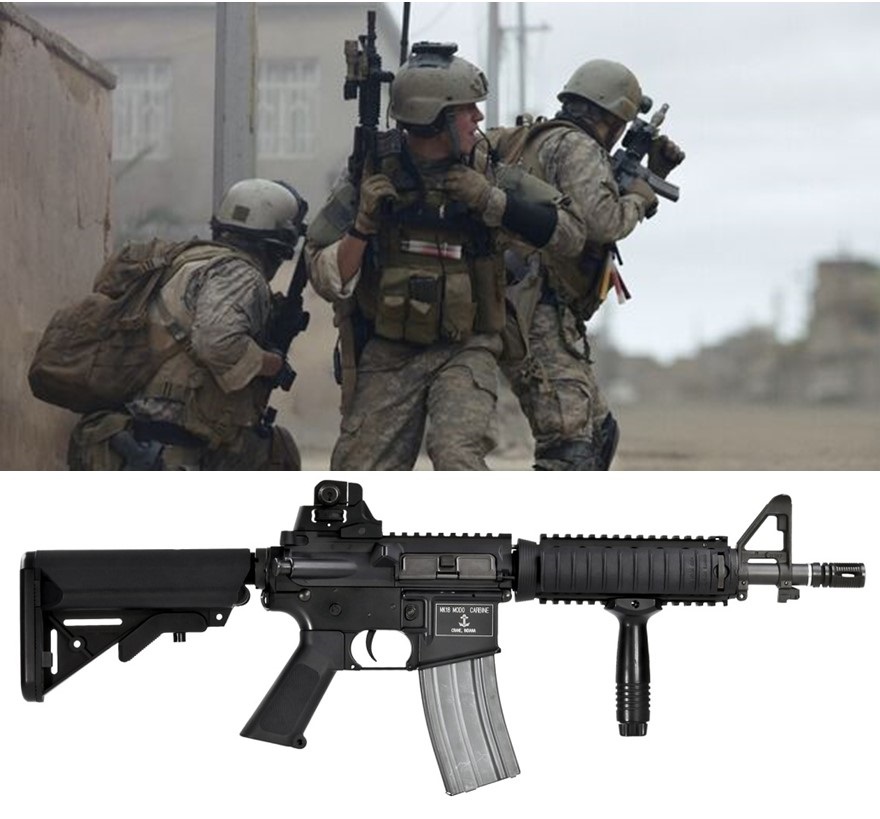MHT Blog
Welcome to the MHT Blog Site and our Posts try to not be dusty topics or blah military history but things we find interesting and hope you will too! Below is our MHT Blog Archive for additional topics. We will have more from the sites we visit now that MHT is back on the road. Thanks for checking us out – The Editor
CLICK TO SEE THE 2025/26 TOURS
SEE the update to the Blog 03/21/2022 - For Want of a Horse, the MiG-29s Were Lost?
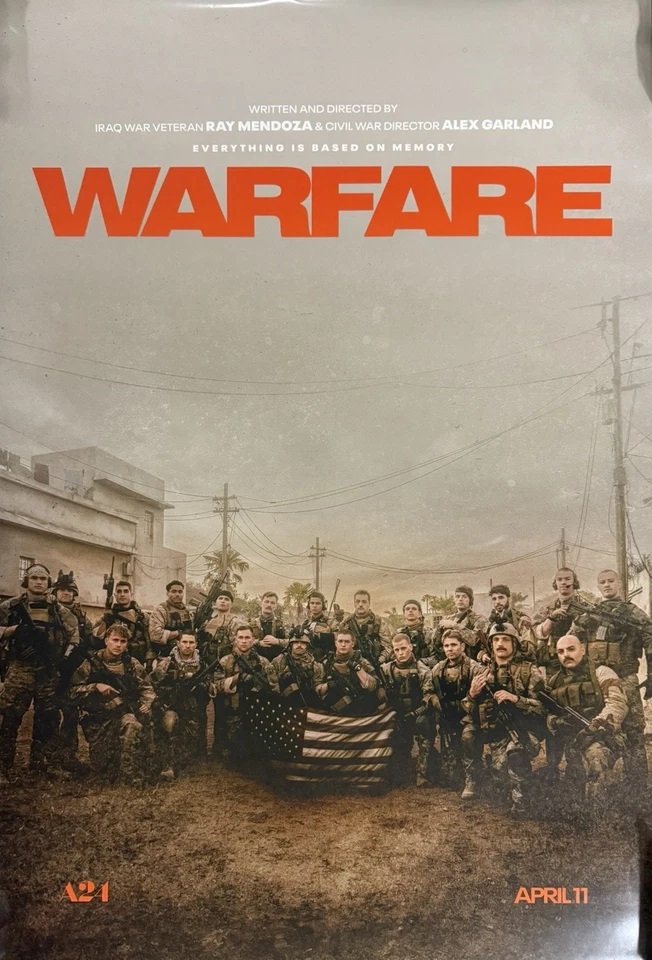
MHT reviews the new movie “Warfare” which is set two years later in Iraq also in a MOUT environment as a platoon of SEALs fight their way out of a building with scenes of intense CQB.
If you are expecting the character driven war movie with the all-knowing Sergeant (Sgt Stryker, SGT Steiner, GYSGT Hartman, SSGT "Wardaddy" Collier, etc.), with there always an Italian American soldier & a Jewish American soldier who both grew up in Brooklyn loving the Dodgers, a British Tommy calls the cigar-chomping southerner “Yank”, southern soldier says “I ain’t no Yankee!”, a country boy who misses his hometown girl, a Polish soldier "Ski", a Texas cowboy who is the crack shot/sniper, a big Machine Gunner (Animal Mother), a young bookish cherry (new guy), a guy who had a run-in with the law & the judge gave him a choice to join or jail, an Indian nicknamed "Chief", plus the 30-year old married guy nicknamed "Pops" you picked the wrong film! This is a single, real-life small unit Military Operation in Urban Terrain (MOUT) on November 19, 2006 during the Battle of Ramadi, Iraq when a platoon of Navy SEALs embarks upon a mission to set up two observation posts within insurgent territory during the battle’s final stages. I won’t do the deep dive like our last blog post on the 2004 Battle of Fallujah but you can click below.
Battle of Ramadi (2006) - Wikipedia
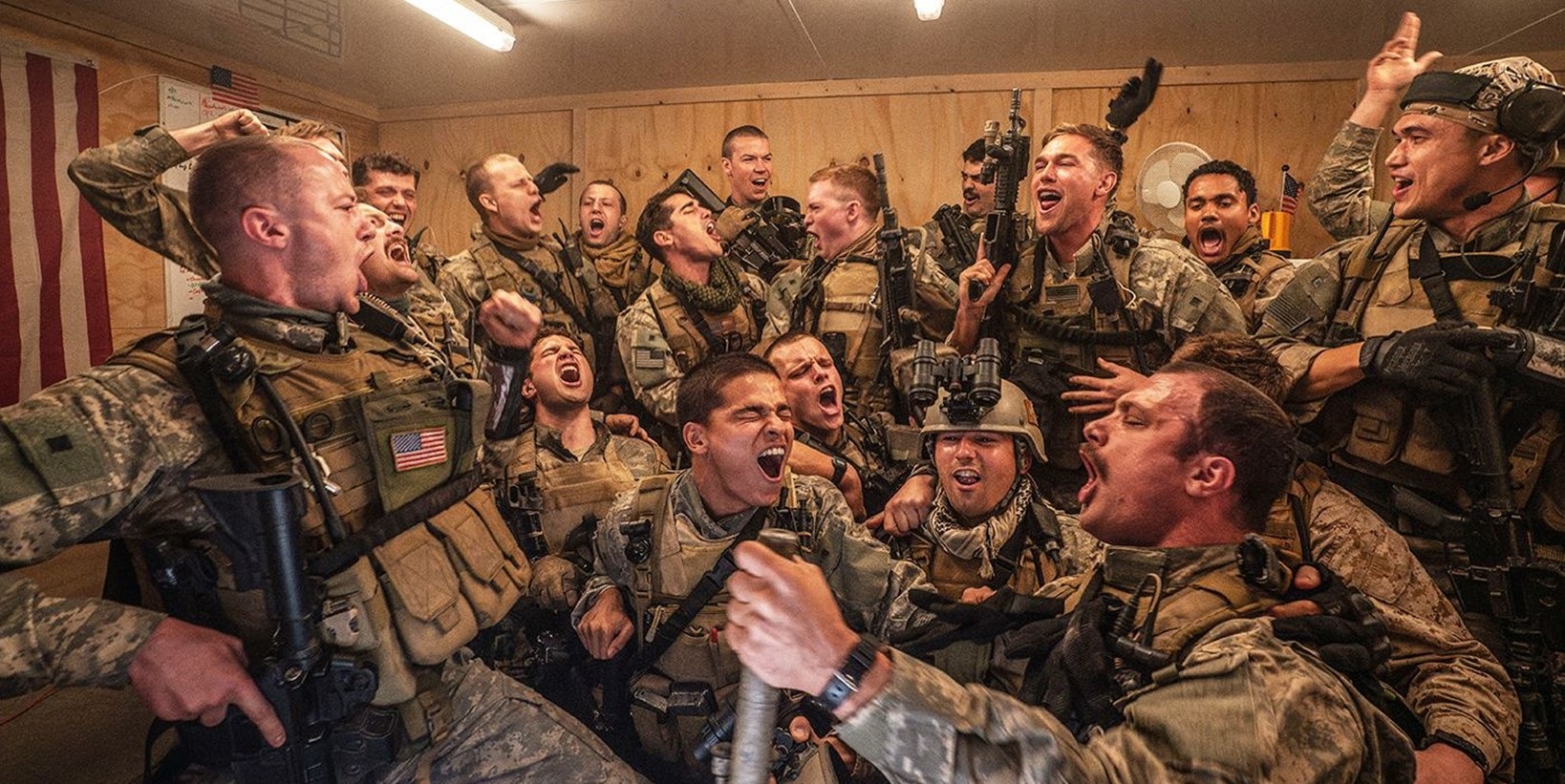
There is no political motivation, no military mission orientation, no tactical maps, no higher headquarters, no extended character development, & no love story. You might think you are in the wrong theater with the movie’s opening (hopefully you saw it with enhanced Dolby Atmos) as Deanne Berry strides into the screen! Wait there was a love story, as you must count the SEAL platoon’s love of the music video “Call On Me” featuring the 2004 music video for the EDM song set in a very high impact aerobics class.
https://www.youtube.com/watch?v=qetW6R9Jxs4&list=RDqetW6R9Jxs4&start_radio=1
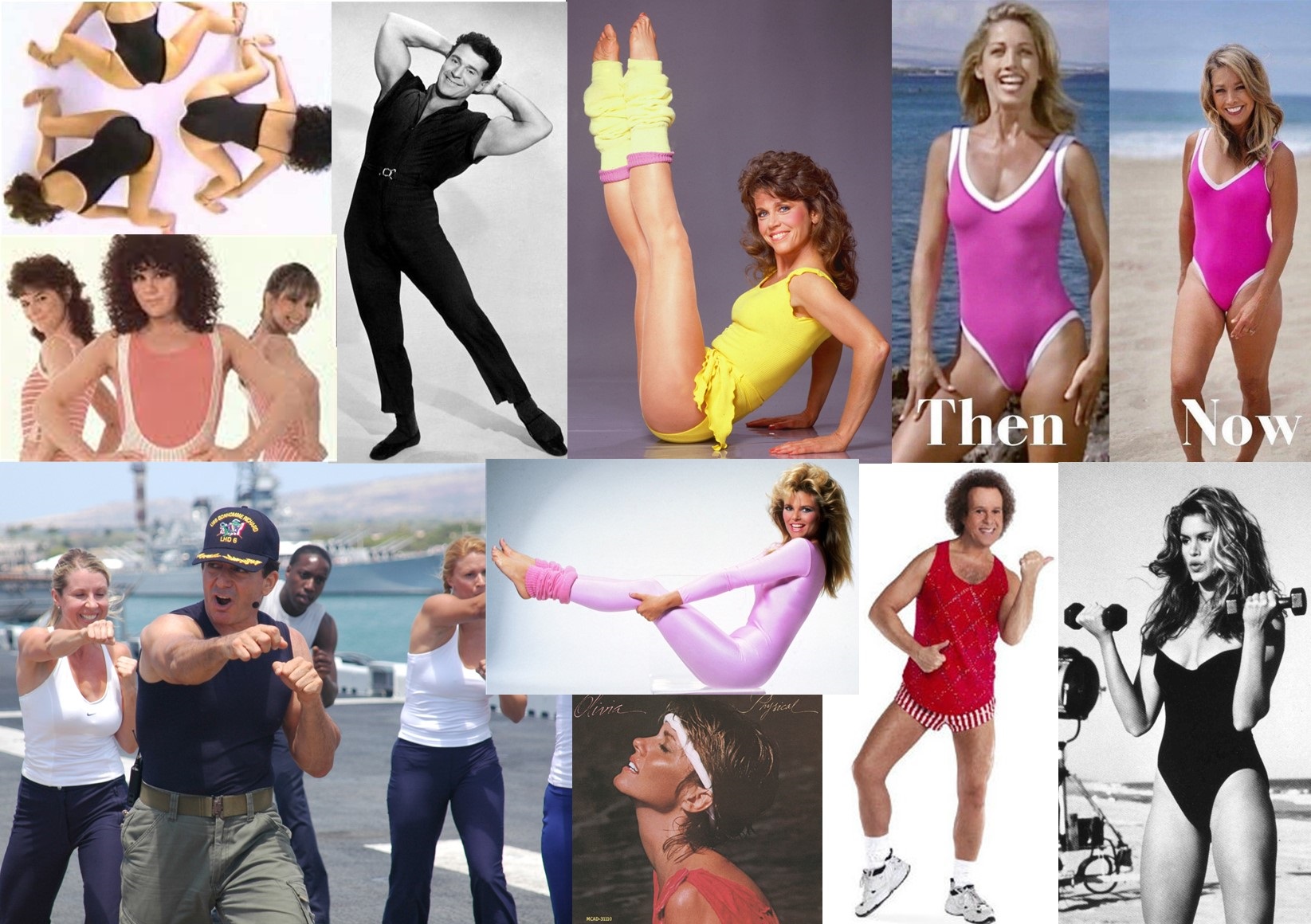
I had a flashback to the 1983-4 HBO :20 Minute Workout & the other 1980’s spandex leotards in neon colors/leg warmers/Jazzercise/step aerobics/headbands/Jane Fonda, Denise Austin, Cindy Crawford, Richard Simmon, Christie Brinkley, Olivia Newton John workouts/Gilad’s TV show “Bodies in Motion” & it certainly wasn’t “The Jack LaLanne Show” of jumpsuit & jumping jacks’ fame.

In late 2004, while being interviewed Tony Blair, the U.K. Prime Minister said: "The first time it came on, I nearly fell off my rowing machine." Everyone immediately knows the melody & due to the iconic music video it’s unarguably the most popular track by Eric Prydz, a Swedish DJ who sampled a twenty-year old Steve Winwood (Spencer Davis, Blind Faith, Traffic) song. Prydz seems to prefer to pretend “Call On Me” doesn’t exist as he stopped playing it the year it was released to ‘distance himself’ from being known as a one hit wonder. That is, until this March, after 20+ years in a surprising turn of events, he decided to play it again in Austin, TX. I doubt it was in conjunction with the movie’s opening.
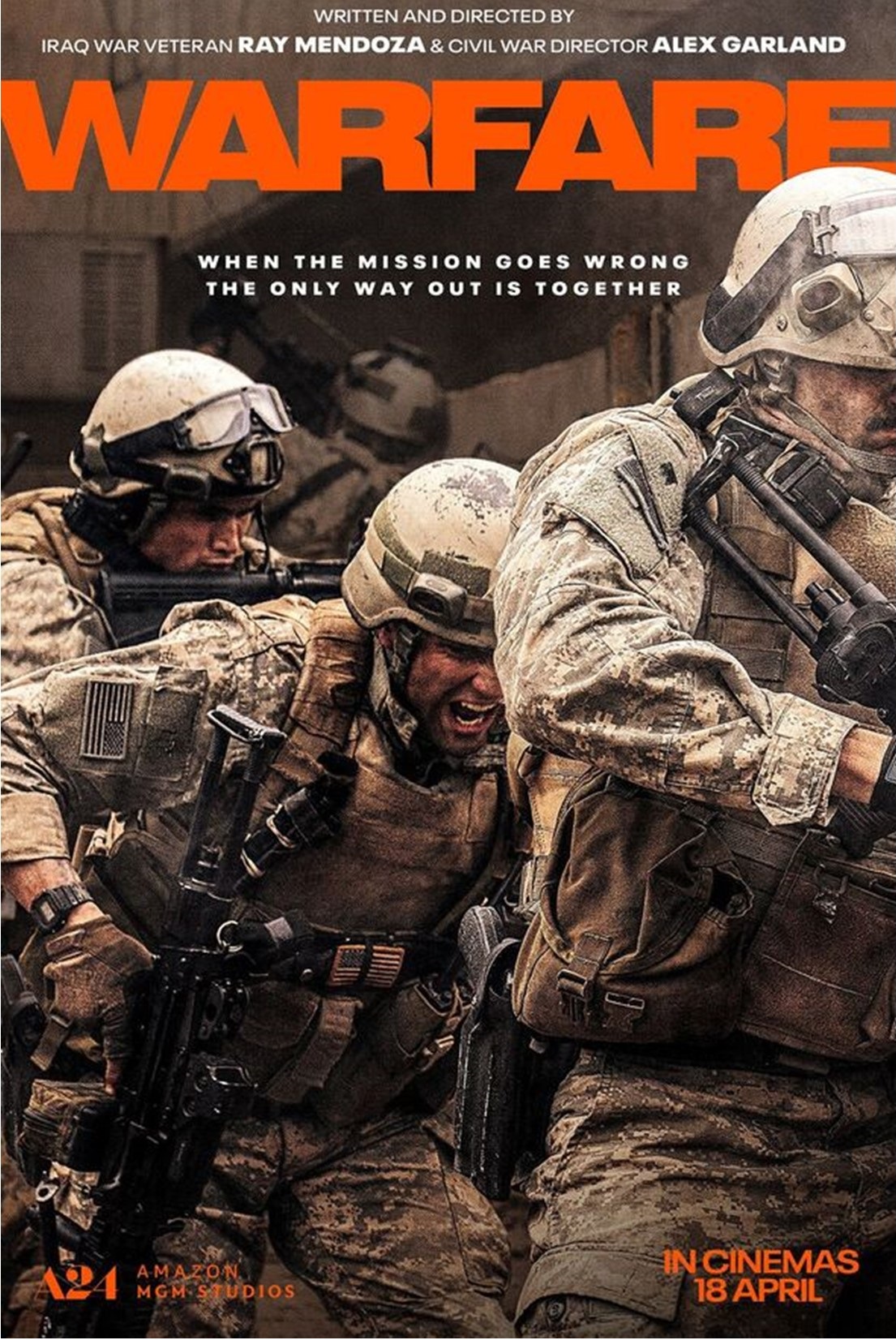
One of the best reviews was from Rahul Malhotra in Collider, the online entertainment publication that focuses on the film & television industry on 12 April 2025: “Harrowing though it may be, “Warfare” is proving to be quite popular with both critics & audiences. The war film is directed by Alex Garland alongside collaborator Iraq War veteran & SEAL Ray Mendoza. Besides Garland & Mendoza co-directing the project they also co-wrote the script. This is their second collaboration as Mendoza served as the military supervisor for Garland’s last film “Civil War.”
It opened to excellent reviews, earning the best Rotten Tomatoes score of Garland’s acclaimed career. Audiences appear to be of the same mind as critics this time around. Warfare debuted in theaters after weeks of pre-release buzz around its knuckle-biting drama & intense narrative, which follows two groups of soldiers engaging Iraqi adversaries in a firefight. The movie is benefiting from this positive response, as it aims to generate around $10 million (actually did $8.3) in its domestic box office debut.” It currently holds a “fresh” 93% approval rating on Rotten Tomatoes, where the critics' consensus reads, “Narratively cut to the bone and geared up with superb filmmaking craft, Warfare evokes the primal terror of combat with unnerving power.” The film’s audience score on the aggregator website is also sitting at 93% currently, which suggests near-universal acclaim. It has maintained its extremely high Rotten Tomatoes rating from film critics at 93% & an audience review of a tremendous 93% rating. Just in case this wasn’t proof enough that Warfare is worth experiencing, opening day audiences awarded it a solid A- grade on “CinemaScore.”
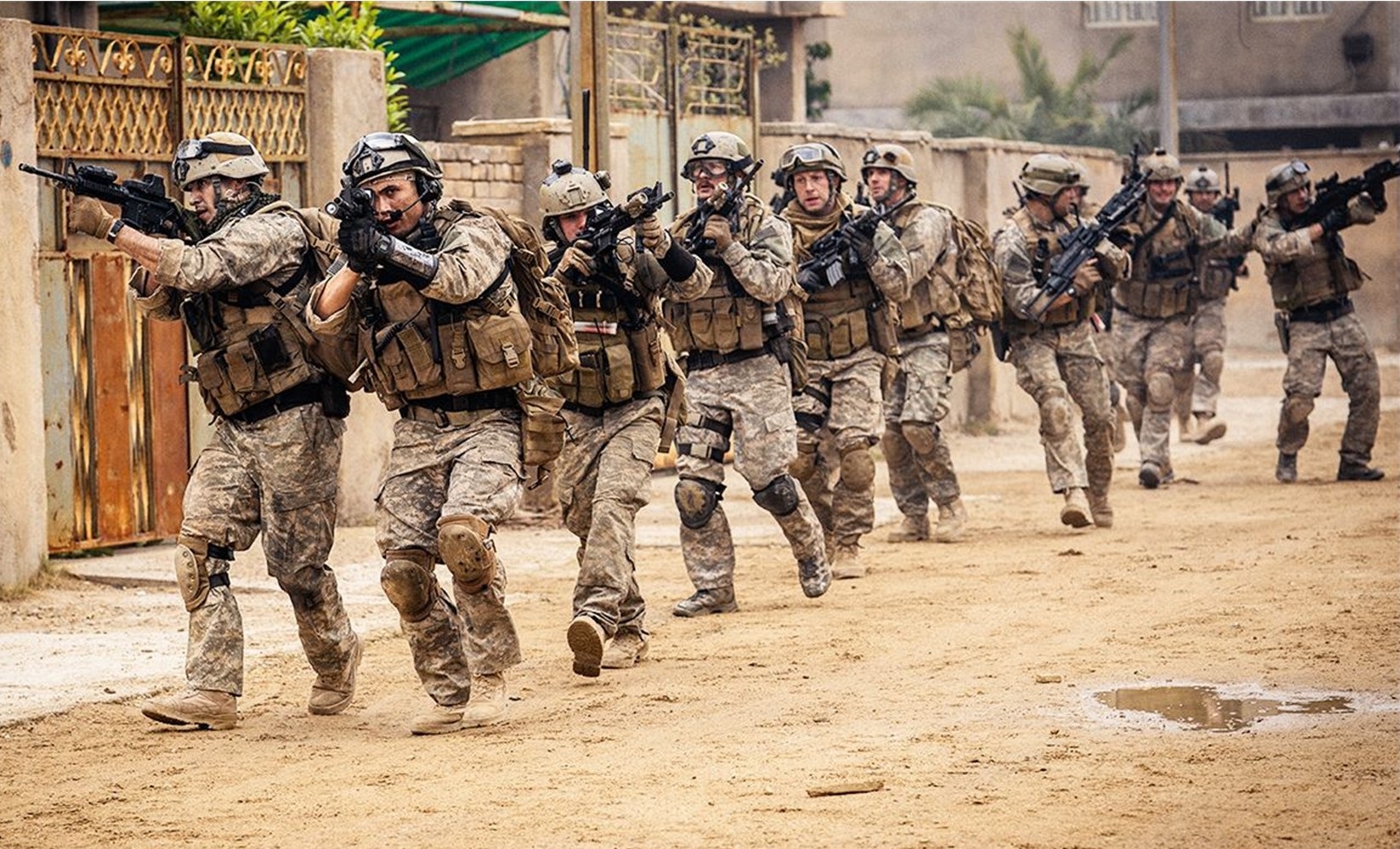
In his review, Collider’s Aidan Kelley described Warfare as “one of the best films of 2025,” adding that it “not only becomes the best tribute to U.S. veterans that it could possibly be, but it also gives viewers a slight sense of what these brave individuals went through to go above and beyond the call of duty.” “Warfare” marks Garland’s third collaboration with the indie movie distributor A24, after the horror film Men, which didn’t perform all that well commercially, and last year’s dystopian thriller Civil War, which emerged as A24’s second-biggest hit ever.
After just two full weeks of release, “Warfare” has recovered its reported budget through its domestic box office revenue alone (before its overseas rollout) even bucking the trend that films with the background of the Iraq War have historically struggled at the box office. For reference, the film’s $26 million domestic revenues easily outdistanced the Best Picture Oscar winner “The Hurt Locker”, which made $17 million in its theatrical run 15 years ago. The movie also scored well in middle America, which traditionally bodes well to become a very popular choice for viewers on home video services.
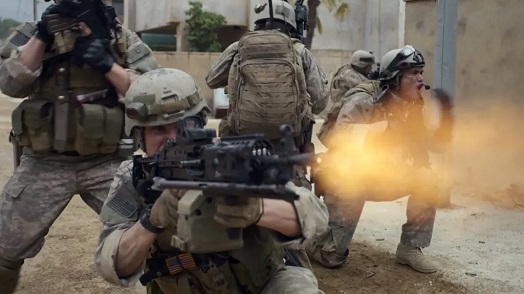
Unfolding almost in close to real-time, the movie has earned praise first for its authentic depiction of Close Quarters Battle (CQB) a tactical approach to armed combat within confined urban spaces, emphasizing quick reflexes, skilled teamwork, & precise maneuvers. Before any bullets are fired it immediately drenches the audience in tension & suspense. The film goes almost dead silent after the music video opening minutes, eerily so as the Seals confidently walk into the heart of the enemy city for this mission. With virtually no music, lots of realistic military jargon, & some occasional moments of levity, you feel as if you are sitting in this dead-silent home alongside these Navy SEALs. Garland & Mendoza also make the very wise decision to rarely show the people that the soldiers are fighting, making things all the more difficult to predict & the enemy more ominous. The seeming boredom builds & builds stress in the viewer knowing that a clash is inevitable.
The second way that “Warfare” utilizes the technical side of filmmaking in creating a sense of immersion is its magnificent Oscar-worthy use of sound. Once the shooting does start, “Warfare” goes from dead silent to overwhelmingly deafening so quickly the woman in the row in front of me elevated six inches out of her seat within a mere instant. The film’s sound design is used to both communicate the SEALs’ mental state & the physical aspect of CQB that they experience. sharing it with the audience through a sensory experience best experienced in a premium theater setting. Primarily through some absolutely top-notch sound design, the crack of every bullet, explosion of grenade, mine or Improvised Explosive Device, & blood-curdling scream will be ringing through one's ears for days. Alex Garland's most impressive feat is how he maintains that high level of tension for almost an hour despite taking place almost entirely in a single location. It makes the immediacy experience that much more real & visceral for the audience. That authenticity is what makes “Warfare” a powerful commentary on what war is without having to empathize any message or plot devices & instead relying on feel & the recreation of physical experiences.
MHT’s 10 Best War Movies that Use Sound to Maximum Effect:
1) Warfare
2) Saving Private Ryan
3) Dunkirk
4) Black Hawk Down
5) 13 Hours: The Secret Soldiers of Benghazi
6) Gladiator
7) Braveheart
8) Midway
9) Aliens
10) Master and Commander: The Far Side of the World
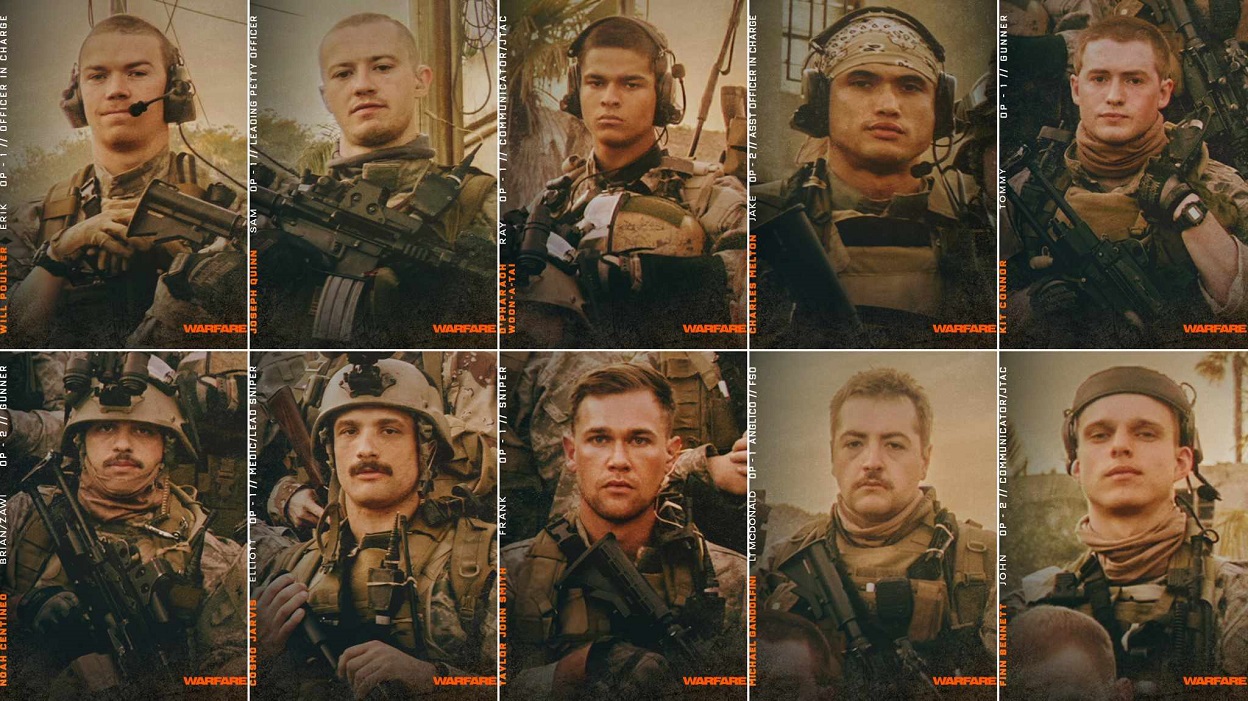
“Warfare” features a remarkable cast of young stars, including D’Pharaoh Woon-A-Tai (Reservation Dogs), Will Poulter (We’re the Millers, The Revenant), Cosmo Jarvis (Shogun), Kit Connor (Rocketman), Finn Bennett (True Detective), Joseph Quinn (The Fantastic Four: First Steps, Gladiator II), Charles Melton (Riverdale), Noah Centineo (The Recruit), Taylor John Smith (Where the Crawdads Sing), Alex Brockdorff (Mission: Impossible – Dead Reckoning Part One), Adain Bradley (Bold & the Beautiful) & Michael Gandolfini (Daredevil.)
Poulter describes the actors attending a pre-filming boot camp as a "condensed and far more manageable, easier version," of the program known as BUD/S (Basic Underwater Demolition/SEAL training) to move, look & act like a SEAL team. Still, it was an "incredibly trying" experience. "They have an expression in the SEAL team: They don't say 'Practice makes perfect,' they say, 'Perfect practice makes perfect,'" the actor explains. "You can practice something a million times, but if you're practicing it wrong, it's not going to result in anything close to perfection. Holding ourselves to higher standards than maybe any of us ever held ourselves to before was really tough." The camaraderie amongst the actors who gave each other nicknames is obvious & gives the film a believable reality.
The Weapons of “Warfare:”
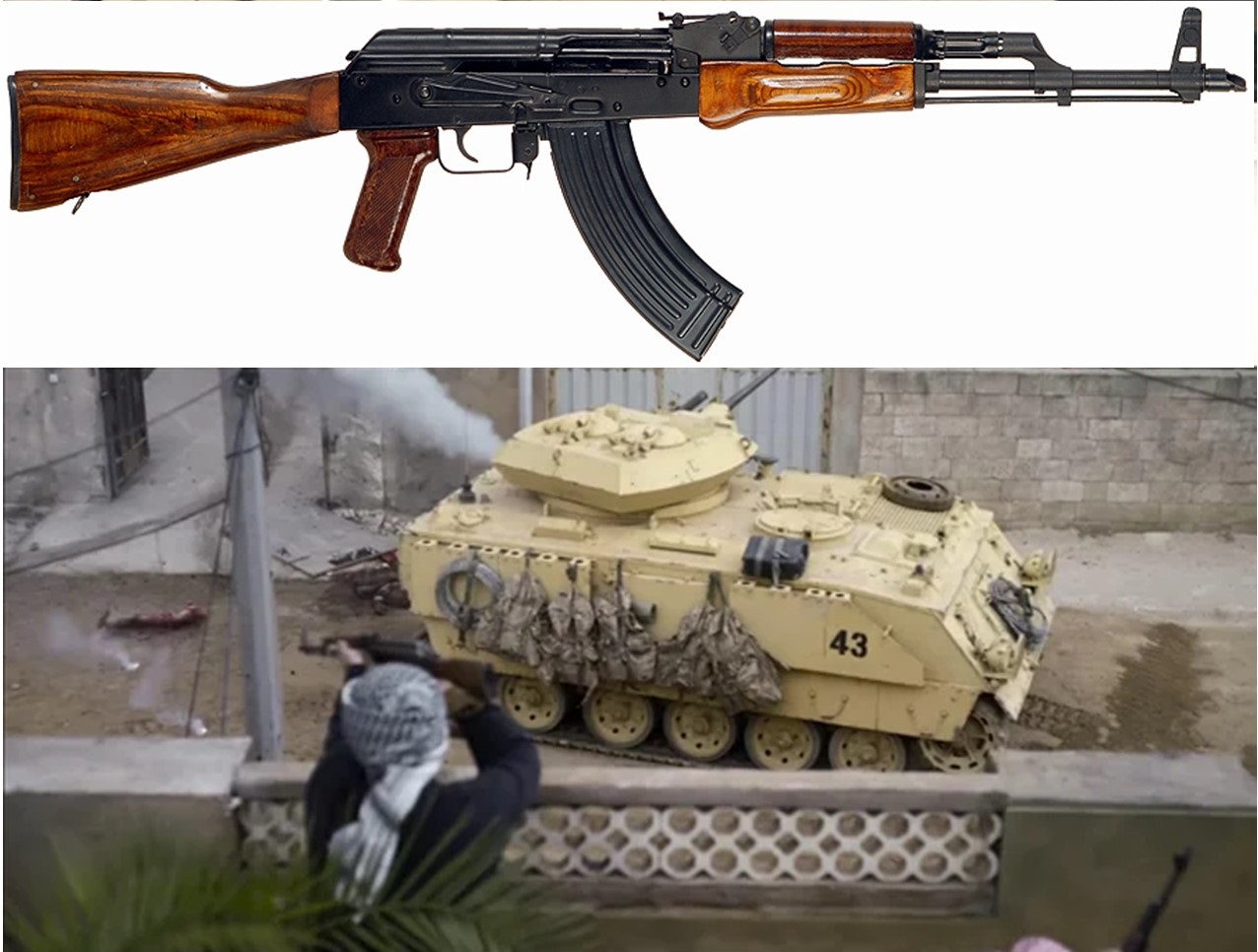
1) The most plentiful weapon for the al-Qaeda insurgents/foreign Muslim terrorists/the five other Sunni Islamist insurgent groups taking part in the Iraqi insurgency against U.S.-led Coalition & Iraqi forces was the soviet standard AKM Assault Rifle a successor to the AK-47.
1. Caliber: 7.62x39mm
2. Weight: 7.3 lbs empty, 8 lbs loaded
3. Length: 34.6 in / Barrel length: 16.3 in
4. Muzzle velocity: 2,346 ft/sec
5. Feed System: 10, 20, 30-round magazines
6. Fire Modes: Semi-Auto (Automatic)/Full-Auto
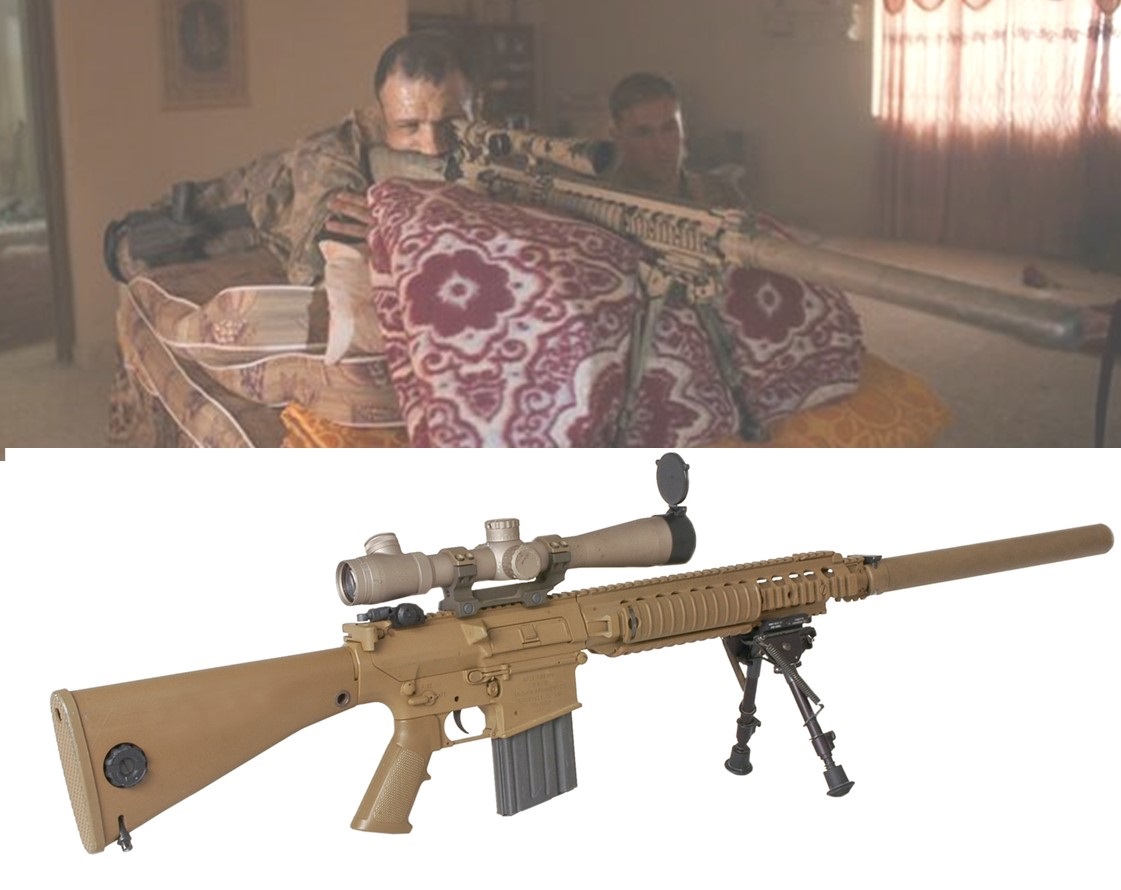
2) The first U.S. Navy SEAL weapon highlighted is the weapon observing the neighborhood from their urban hide site is the M110 Semi-Automatic Sniper System (SASS) sniper rifle with a muzzle mounted, detachable sound suppressor, Harris bipod & tan paint scheme.
1. Caliber: 7.62×51mm NATO
2. Weight: 10.8 lbs
3. Length: 44 in / Barrel length: 24 in
4. Capacity: 10 or 20-round magazines
5. Fire Modes: Semi-Auto
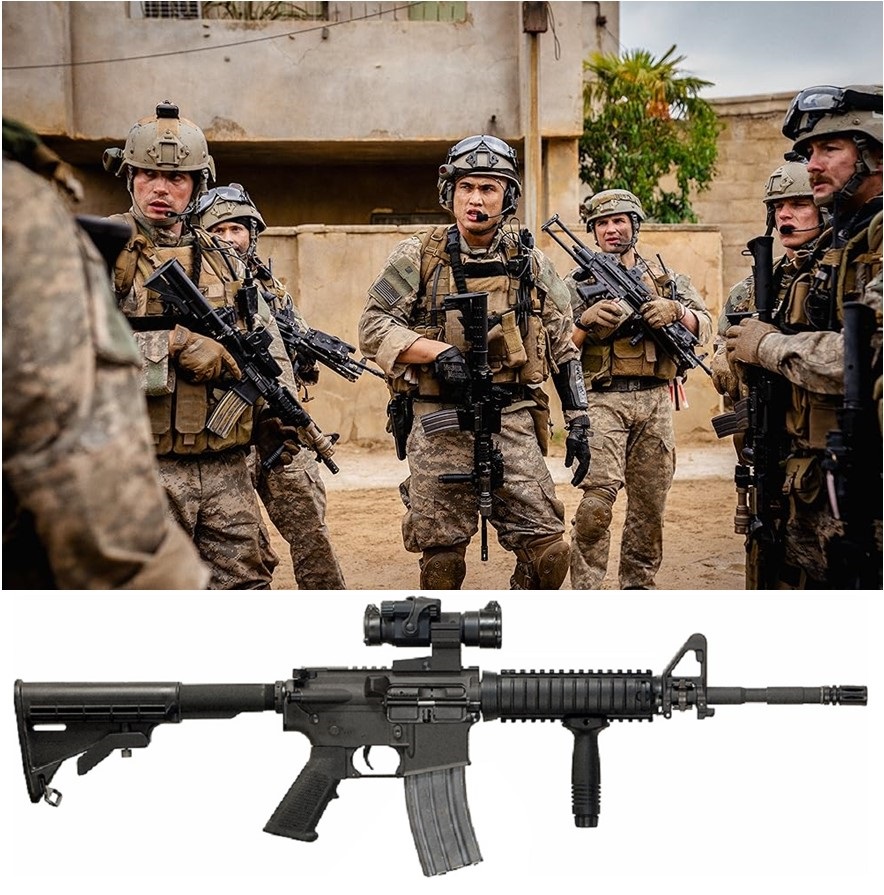
3) The most common SEAL assault rifle is the Colt M4A1 Carbine with M68 Aimpoint reflex optic, Knight's Armament RAS railed handguard and vertical forward grip. The M4 Carbine is a 14.5" barreled select fire assault rifle adopted by the United States Armed Forces. It has a distinctive 'step down' in the barrel to allow for mounting of a M203 40mm grenade launcher.
4) Some of the SEALs use Mk 18 Mod 0 Close Quarter Battle (CQB) carbines with various accessories including foregrips, AN/PEQ-2 and AN/PEQ-15 IR designators, flashlights and foregrips. It is an even shorter-barreled M4A1 carbine with a 10.5-inch barrel. The upper receiver, which is used on a regular M4 lower receiver, is designated CQB-R (Close Quarters Battle-Receiver.)
1. Caliber: 5.56x45mm NATO
2. Weight: M4A1 – 7.74 lbs / Mk 18 MOD 0 – 6 lbs
3. Length: M4A1 – 33 in (stock extended) 29.75 (retracted) /Mk 18 MOD 0 - 30 in (extended) 26.75 (retracted)
4. Capacity: STANAG Magazines: 5, 20, 30, 40 round box magazine/ 90 rd snail drum/ 100 rd dual drum Beta-C magazine
5. Fire Modes: Safe/Semi-Auto/Auto
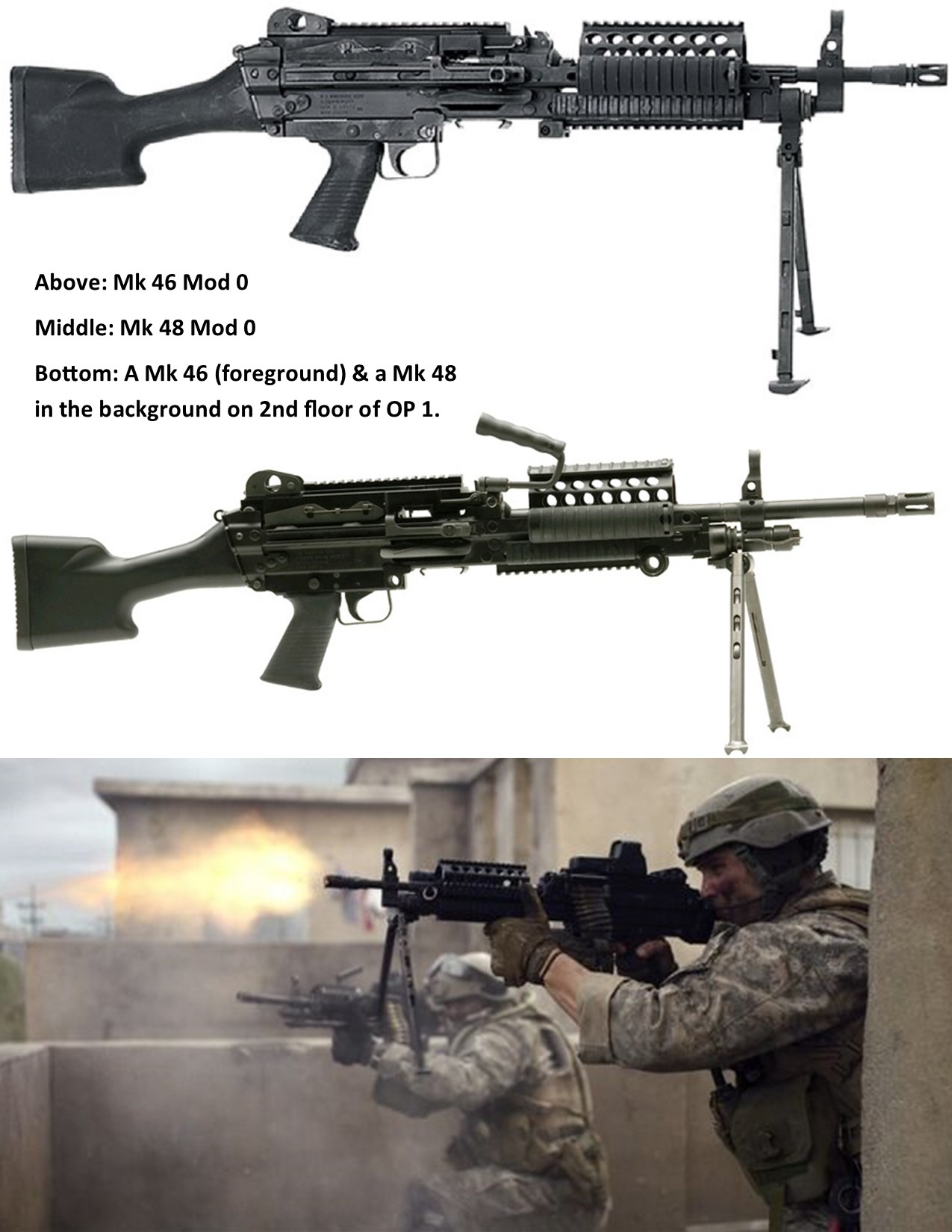
5) The most important weapon the SEALs possessed were the Mk 46 & 48 Mod 0s, gas-operated, air-cooled, belt-fed lightweight machine gun (LWMG) in use with United States special operations forces (SOF) since 2003. They are variants of the M249 Squad Automatic Weapon (SAW) light machine gun distinguishable by the shorter barrels. The Mk 46 & Mk 48 are fitted with cloth belt pouch magazine, KAC foregrips, EOTech 512 Holographic sights & AN/PEQ-2 IR designators. The SEALs using the Mk 46 Mod 0s are fitted with a Paratrooper-style collapsible stock & distinguishable by the shorter barrels.
Mk 46 Mk 48
1. Caliber: 5.56x45mm NATO 7.62x51mm NATO
2. Weight: 15.43 lbs (empty) 18.5 lbs (empty)
3. Length: 36.18 inches 39.5 inches
4. Rate of fire: 750 rpm
5. Capacity: 100 or 200-round disintegrating belt in soft pouch
6. Fire Modes: Automatic
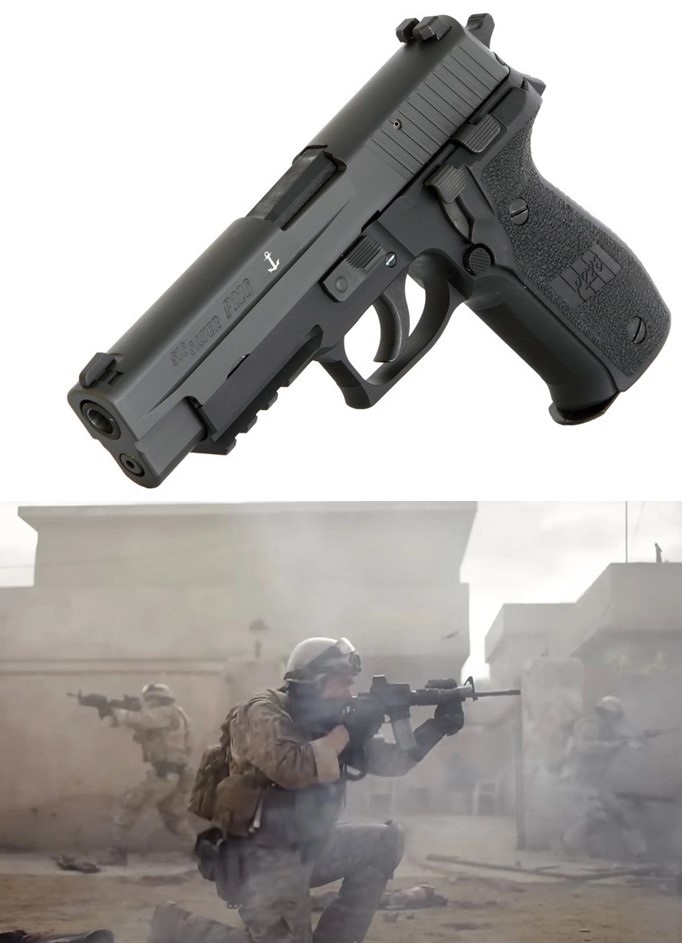
6) Sig Sauer P226 sometimes called the, “Gold Standard by which all other combat handguns are measured.” Reliability will always be the number one factor to consider for the Navy SEALs who count on it in & out of the water, sand & mud to pull it out of its holster & it’s going to fire. It has a proven track record that operators can stake their life on during every mission.
1. Caliber 9mm Luger (9x19 PARA)
2. Weight: 34.4 oz
3. Overall Length: 7.7 inches
4. Barrel Length: 4.4 inches
5. Finish: Black (Engraved Anchor)
6. Capacity: 10 rd magazine
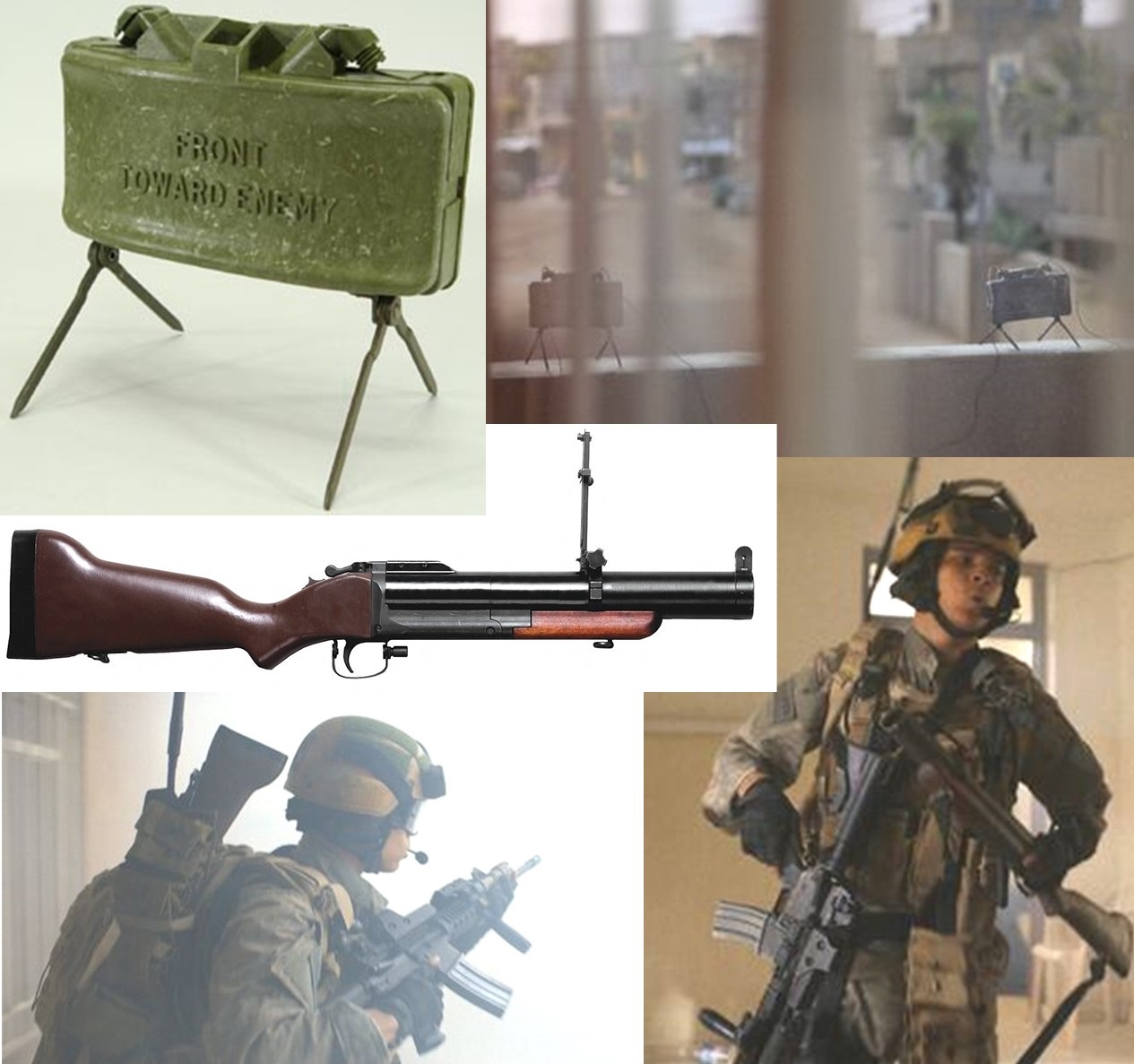
7) Throwback weapons: The M18A1 Claymore mine is directional anti-personnel mine developed for the U.S. Armed Forces. Named after a large medieval Scottish sword it became iconic for its lethality & iconic “Front Toward Enemy” printed on its convex plastic casing. Unlike a conventional land mine, the Claymore may be command-detonated shooting 700 metal ball bearings pointed towards the enemy’s approach route in a 60-degree pattern kill zone. Never used but mentioned is the Vietnam War era M79, a single-shot, shoulder-fired grenade launcher. It is known for its unique "thump" sound & was nicknamed "Thumper" or "Blooper." The M79 can fire a wide variety of 40 mm rounds, including explosive, anti-personnel, smoke, buckshot, flechette & illumination. Ray has one for the SEALs.
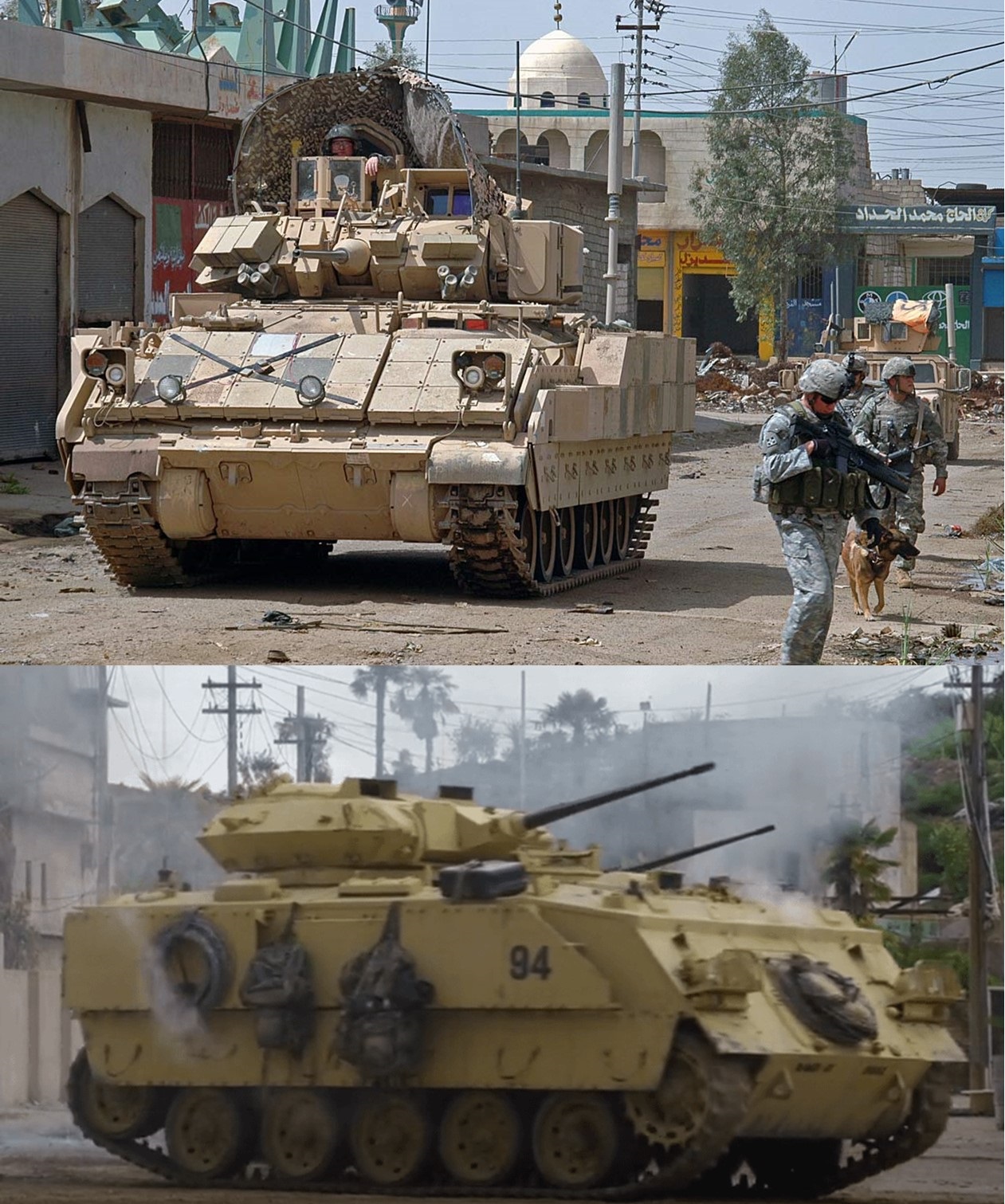
8) The US Army used M2 Bradley Fighting Vehicles for CASVAC (Casualty Evacuation) to remove Wounded in Action (WIA) soldiers, sailors, & Marines from the battlefield. Since it was filmed in England the production crew had to substitute the British Army FV432 armoured fighting vehicles with the RARDEN turret mocked up as M2s. The film’s central drama is fueled by the required CASVAC of two severely WIA SEALs. Above picture is of a Bradley on top & the FV432 in the film. The CASVAC in the film is seen below.

In the historical background, in early June 2006, the US Army’s 1st Brigade Combat Team (BCT) of the 1st Armored Division with various attached units were deployed to the Ramadi area of operations. Rumors of the impending offensive had already gotten to the city’s 400,000 citizens who feared another Fallujah style attack. But the U.S. commander of 1st BCT, Colonel Sean MacFarland decided to take it slowly & subtly, without using heavy close air support or artillery fire. Tanks were used to safeguard Marines, soldiers & SEALs against IEDs & were key in targeting bunkered insurgents, hardened positions & snipers.
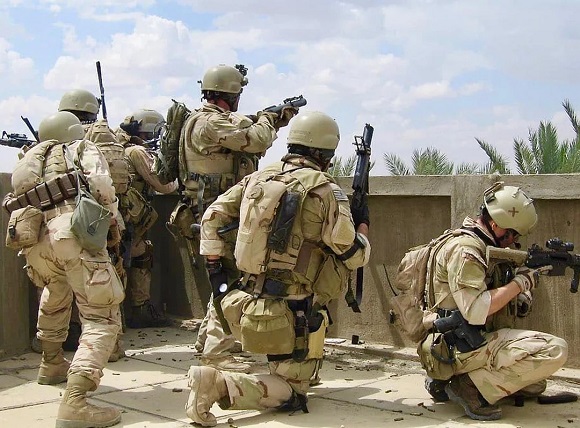
Actual Team 3 Frogmen on a rooftop with a real M-79 in 2006.
SEAL Team Three was sent to Ramadi in April 2006 & assigned to train Iraqi Army soldiers at Camp Corregidor outside of Ramadi. As a communicator & assigned a LWMG on patrols, Petty Officer 2nd Class Michael Monsoor carried 100 pounds of gear in temperatures often exceeding 100 °F. He took a lead position to protect the platoon from frontal assault & his team was frequently involved in battles with insurgent fighters during the deployment’s first five months. During fighting on 9 May 2006, Monsoor ran into a street while under continuous insurgent gunfire to rescue an injured comrade. Monsoor was awarded the Silver Star for this action.
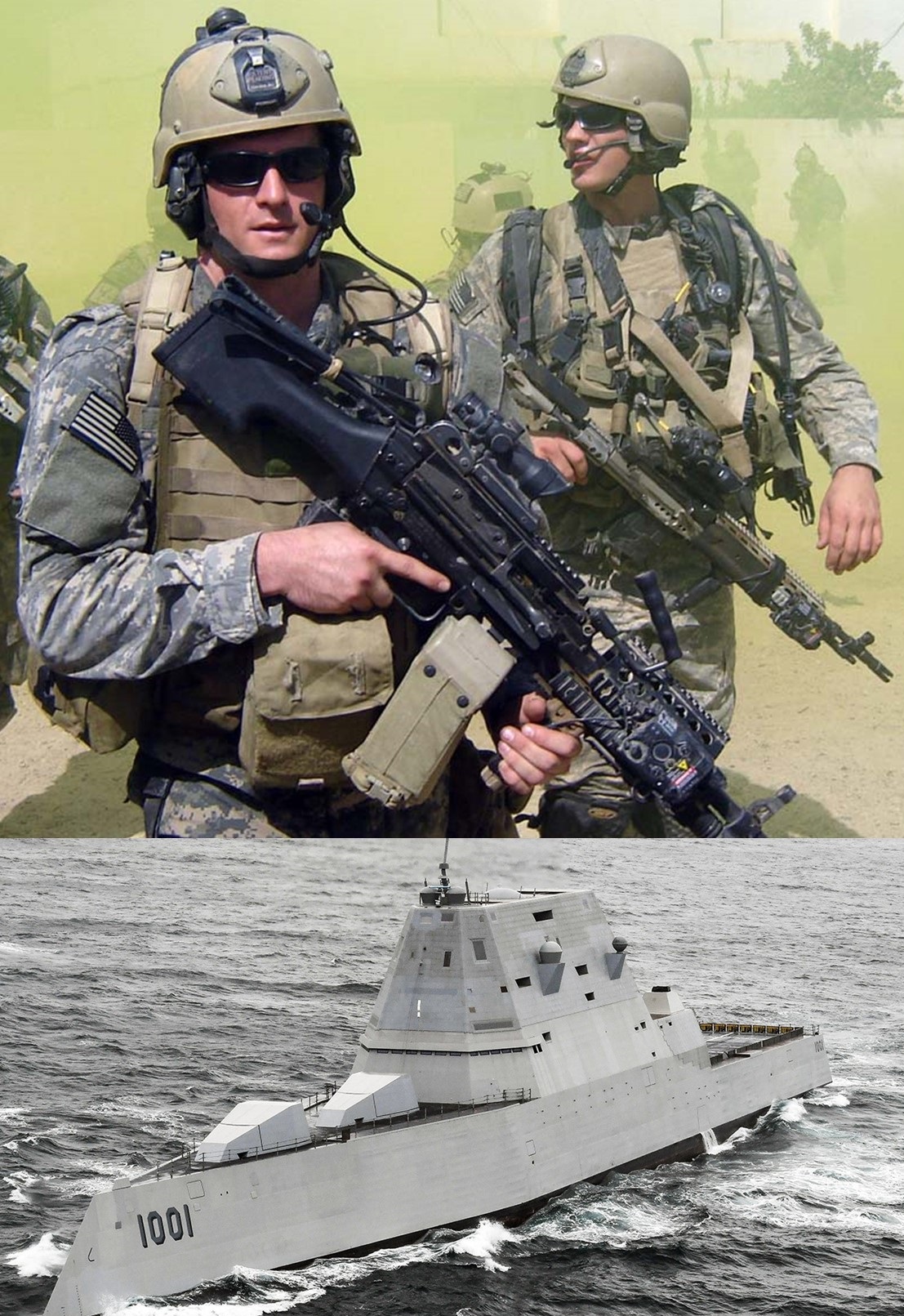
On 29 September, Monsoor's platoon engaged four insurgents in a firefight in Ramadi, killing one & wounding another. Anticipating further attacks, Monsoor, three SEAL snipers & three Iraqi Army soldiers took up a rooftop overwatch position. After a nearby Islamic Mosque broadcast a message for people to fight against the Americans & the Iraqi soldiers. A grenade was thrown onto the rooftop by an insurgent on the street below. The grenade hit Monsoor in the chest before falling to the floor. Immediately, Monsoor yelled "Grenade!" & jumped onto the grenade, covering it with his body. The grenade exploded seconds later, and Monsoor's body absorbed most of the blast’s force. Monsoor was severely wounded & although evacuated immediately the medical attention couldn’t save his life. Two other SEALs next to him at the time were injured by the explosion but survived. He was posthumously awarded the Medal of Honor for his selfless action. His heroism was honored by the US Navy by naming the second ship of the three-ship Zumwalt-class of guided missile destroyer, the USS Michael Monsoor (DDG-1001.)
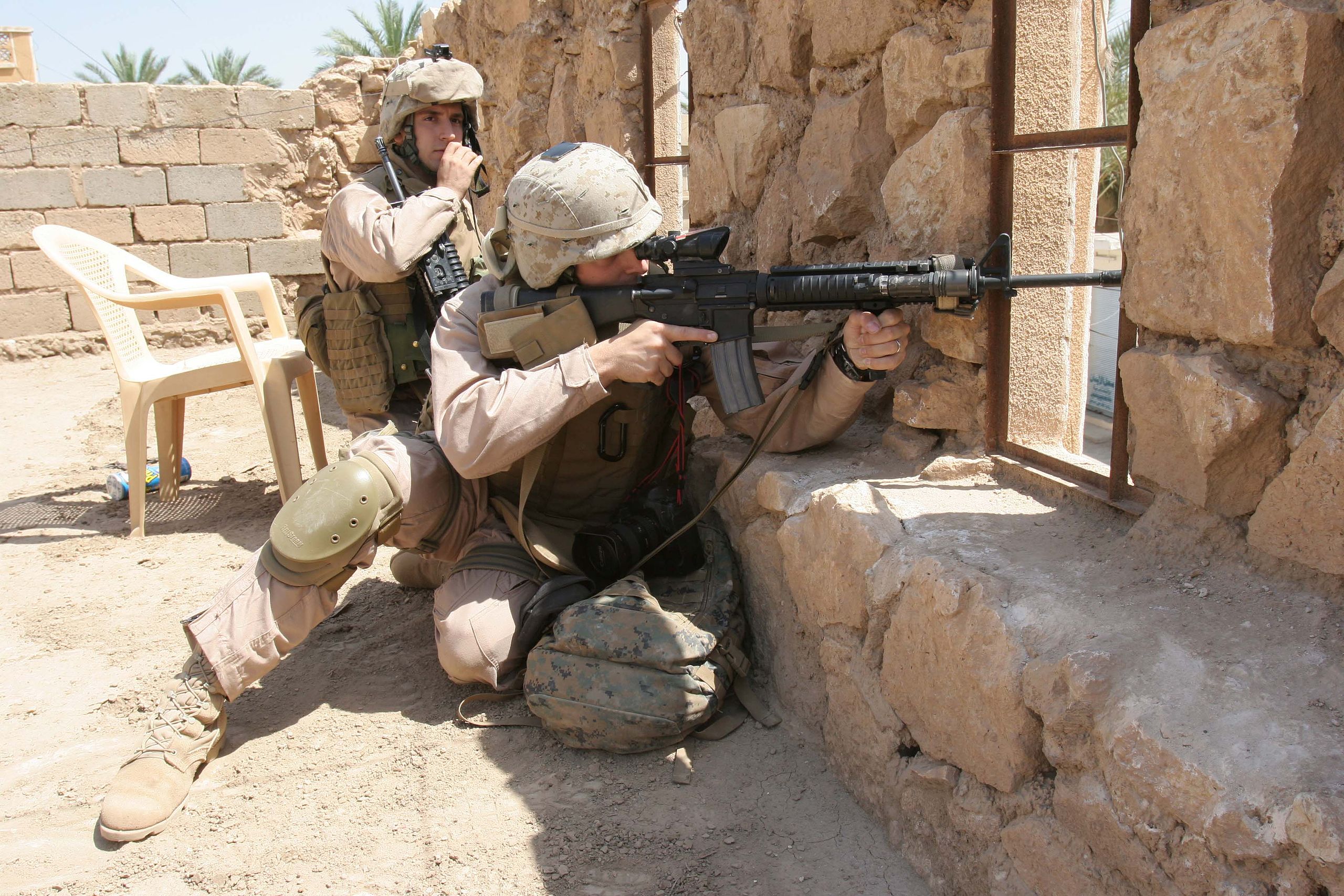
Above: Marines from India Company 3rd Battalion, 8th Marine Regiment in Ramadi.
Aftermath
By mid-November at least 75 American Marines, soldiers & SEALs were KIA along with an unknown number of Iraqi soldiers & police. The U.S. commander, Col. MacFarland said 750 terrorists & insurgents were killed in fighting in Ramadi & that his forces had secured 70% of the city. The intense battles of October & November 2006 largely eliminated al-Qaeda & other foreign terrorists, the surviving militants fled the city, some turning up in Baghdad & elsewhere, whilst others simply melted into the population.
The End (Deanne Berry from the film’s first scene)

MHT Blog Archive
05/30/2025 – MHT Movie Review of “Warfare”
03/23/2025 – The Battles of Fallujah
12/22/2024 – JFK & The Andrew Jackson
12/03/2024 – Guam MHT’s Favorite Basecamp
09/09/2024 – Rocket Ramblings
07/16/2024 – MHT’s Top 10 Iconic Photographs
06/28/2024 - 40th Anniversary of the Battle of Iwo Jima
06/04/2024 – Discovering PT-109
05/01/2024 – The Space Marines in “Aliens”
03/30/2024 – MHT’s Top 10 War Comic Books
03/01/2024 – Totenkopf – “The Death Head”
01/29/2024 – MHT’s Movie Review of “Napoleon”
12/22/2023 – MHT’s Holiday Toast
12/05/2023 – MHT’s Oppenheimer Movie Part II
10/17/2023 – MHT’s “Oppenheimer” Movie Review
08/25/2023 – Women in the Vietnam War
06/19/2023 – “Body & Soul” U.S. Navy in Vietnam
05/12/2023 - The White Rajahs of Sarawak
03/24/2023 - The MHT Movie Awards
02/16/2023 – Top 20 D-Day Movies
01/12/2023 – WWII Japanese Holdouts
12/13/2022 – Jerry’s WWI Journey with MHT
11/22/2022 – Movie Devotion
11/09/2022 – Cancel Culture China
10/07/2022 - Jeff's Pirates Cove, Guam
09/20/2022 - Truth vs the Fantasy of a Playmate in VN 1966!
08/21/2022 – Top 10 Secret Police
08/07/2022 – MHT’s French Adventure 5th Post Le Mans
07/26/2022 – MHT’s French Adventure 4th Post Lyon
07/13/2022 – MHT’s French Adventure 3rd Post Geneva
07/05/2022 – MHT's French Adventure 2nd Post Dijon
06/22/2022 – MHT French Adventure – 1st Post Paris
06/20/2022 – MHT Movie Review – Judgement at Nuremberg
05/21/2022 – Top Cover for D-Day
03/31/2022 - Women in Combat in Ukraine
03/21/2022 – For Want of a Horse, the MiG-29s Were Lost?
02/27/2022 – MHT Movie Review – The North Star
01/10/2022 – Sailors a Girl in Every Port...Myth or Truth!
12/16/2021 – A Marine Hero & a Bell Return
12/04/2021 - MHT Wartime & Military Musicals
11/20/2021 – Teak & Orange – And Night Became Day
09/18/2021 – The Best & Worst Tank Movies
08/31/2021 – The World’s Most Important Bomber
08/15/2021 - VJ Day Almost Wasn't
08/09/2021 – Tinian – Atomic Bomb Island
08/05/2021 - Suni Lee & the Hmong's Secret War
07/28/2021 – The Fate of the USS Indianapolis
07/11/2021 - Battle of Saipan Facts & Fiction
07/03/2021 – Humphrey Bogart’s Top 10 WWII Movies
06/13/2021 - Three Okinawa Temple Bells
06/06/2021 - Battle of Midway
05/26/2021 - WWI "Through the Eyes of a Marine"
05/16/2021 – A Journey to Sugar Loaf Hill
05/04/2021 – MHT Movie Review – WWI Aviation
04/24/2021 – Manfred von Richthofen – The Red Baron
04/19/2021 - Death of the Wehrmacht
04/10/2021 – The Three Bells of Balangiga
04/07/2021 - The Iraqi Thunder Runs
03/29/2021 - Women in the Military Trifecta Movie Review
03/22/2021 - Iwo Jima & Baron Nishi
03/19/2021 – The History of the Iron Cross
03/12/2021 – MHT Movie Reviews - John Garfield WWII Trifecta
03/05/2021 - MHT Reviews TV's Special Ops Shows
02/26/2021 – MHT Movie & Book Review “Flight of the Intruder”
02/23/2021 - A Salute to the Flag Raisings on Mount Suribachi
02/19/2021 - Anzio Beachhead on the Brink
02/16/2021 – MHT Salutes the Gallant Defense of Chipyong-ni
02/09/2021 – MHT Movie Review of “The Eagle Has Landed”
02/01/2021 - "Picture That Lost the Vietnam War"
01/27/2021 – MHT Looks in the Old Footlocker
01/21/2021 – MHT Movie Review: The James Garner 1964 D-Day Doubleheader
01/11/2021 – MHT Movie Review “WWI in the Movies / The African Queen”
01/09/2021 – Cape Gloucester – “The Green Hell”
01/06/2021 – USS Saginaw – Midway, Cure, Kauai & Oahu Islan
01/03/2021 - Solomon Island Campaign
12/30/2020 - Battle of the Bulge – Part 5 – “Kampfgruppe Peiper Leaves Massacres in Its Wake”
12/26/2020 - Battle of the Bulge – Part 4 – “General Patton’s Drive North”
12/23/2020 - Battle of the Bulge – Part 3 – “General Patton’s Famous Weather Prayer”
12/22/2020 - Battle of the Bulge – Part 2 - “Bastogne Surrounded”
12/19/2020 - Battle of the Bulge – Part 1 – “German Special Operations”
12/16/2020 - MHT Movie Reviews - U.S. Military Academy
12/11/2020 - Chosin Reservoir - Tootsie Rolls
12/10/2020 - Chosin Reservoir - Retreat Hell!
12/09/2020 – Chosin Reservoir – My Division for a Bridge Over Frozen Water
12/08/2020 – Chosin Reservoir – Not a Retreat, Just Fighting in Another Direction
12/07/2020 – Pearl Harbor – Hawaii
12/06/2020 – MHT Movie Reviews – The Dirty Dozen & Where Eagles Dare
12/03/2020 - Deployment Military Baggage – The Valpak
12/01/2020 – Chosin Reservoir – RCT-31 & Task Force Faith
11/30/2020 – 245th USMC Birthday – Quantico, VA
11/27/2020 – Civil War – Artilleryman’s Delight
11/26/2020 – Civil War – Fort Sumter
11/25/2020 – Korean War – Chinese 2nd Phase Offensive
11/24/2020 – Saipan – Bombing of Tokyo
11/23/2020 – Stalingrad – Russia Eastern Front
11/22/2020 – China Clipper – Inaugural Flight
11/21/2020 – Nuremberg – Military Tribunal
11/20/2020 – The Big Guns of Tarawa
11/19/2020 – MHT Movie Review: Casablanca
11/18/2020 –

